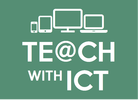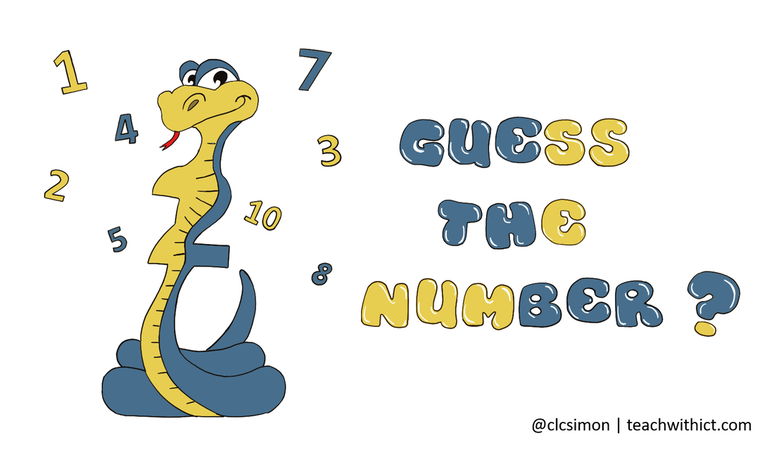Guess the number (High / low game) - Python lesson
Guess the number tutorial
Learning Objectives:
- Understand and use sequence in an algorithm
- Understand and use iteration in an algorithm (FOR and WHILE loops)
- Understand and use selection in an algorithm (IF, Else and Else if)
Curriculum Mapping:
KS2:
- Design, write and debug programs that accomplish specific goals; solve problems by breaking them into smaller parts. Select, use and combine a variety of software on a range of digital devices to design and create a range of programs.
- Use sequence, selection and repetition in programs; work with variables and various forms of input and output
- Use logical reasoning to explain how some simple algorithms work; detect and correct errors in algorithms and programs
KS3:
- Use two or more programming languages, at least one of which is textual, to solve a variety of computational problems.
STUDENT: COMPUTATIONAL THINKER:
- 5a: Students break problems into component parts, extract key information, and develop descriptive models to understand complex systems or facilitate problem-solving.
- 5c: Students break problems into component parts, extract key information, and develop descriptive models to understand complex systems or facilitate problem-solving.
- 5d: Students understand how automation works and use algorithmic thinking to develop a sequence of steps to create and test automated solutions.
EDUCATOR: COMPUTATIONAL THINKING COMPETENCIES:
- 4b: Design authentic learning activities that ask students to leverage a design process to solve problems with awareness of technical and human constraints and defend their design choices.
COMPUTER SCIENCE EDUCATORS:
- 2a: Plan and teach computer science lessons/units using effective and engaging practices and methodologies:
i. Select a variety of real-world computing problems and project-based methodologies that support active and authentic learning and provide opportunities for creative and innovative thinking and problem solving
ii. Demonstrate the use of a variety of collaborative groupings in lesson plans/units and assessments
iii. Design activities that require students to effectively describe computing artifacts and communicate results using multiple forms of media
iv. Develop lessons and methods that engage and empower learners from diverse cultural and linguistic backgrounds
v. Identify problematic concepts and constructs in computer science and appropriate strategies to address them
vi. Design and implement developmentally appropriate learning opportunities supporting the diverse needs of all learners
vii. Create and implement multiple forms of assessment and use resulting data to capture student learning, provide remediation and shape classroom instruction
CSTA K–12 CS Standards:
- 1B-AP-08: Compare and refine multiple algorithms for the same task and determine which is the most appropriate.
- 1B-AP-09: Create programs that use variables to store and modify data.
- 1B-AP-10: Create programs that include sequences, events, loops, and conditionals.
- 1B-AP-11: Decompose (break down) problems into smaller, manageable subproblems to facilitate the program development process.
- 1B-AP-13: Use an iterative process to plan the development of a program by including others' perspectives and considering user preferences.
- 1B-AP-15: Test and debug (identify and fix errors) a program or algorithm to ensure it runs as intended.
- 1B-AP-17: Describe choices made during program development using code comments, presentations, and demonstrations.
- 2-AP-11: Create clearly named variables that represent different data types and perform operations on their values
- 2-AP-12: Design and iteratively develop programs that combine control structures, including nested loops and compound conditionals.
- 2-AP-15: Seek and incorporate feedback from team members and users to refine a solution that meets user needs.
- 2-AP-16: Incorporate existing code, media, and libraries into original programs, and give attribution.
- 2-AP-17: Systematically test and refine programs using a range of test cases.
- 3A-AP-14: Use lists to simplify solutions, generalizing computational problems instead of repeatedly using simple variables.
- 3A-AP-15: Justify the selection of specific control structures when tradeoffs involve implementation, readability, and program performance, and explain the benefits and drawbacks of choices made.
AREA OF LEARNING AND EXPERIENCE: Science and Technology:
Computation is the foundation for our digital world.
Progression step 3
- I can use conditional statements to add control and decision-making to algorithms.
- I can identify repeating patterns and use loops to make my algorithms more concise.
- I can explain and debug algorithms.
Progression step 4
- I can decompose given problems and select appropriate constructs to express solutions in a variety of environments.
- I can select and use data structures that efficiently manage data in algorithms.
- I can plan and implement test strategies to identify errors in programs.
Progression step 5
- I can identify, define and decompose problems, choose appropriate constructs and express solutions in a variety of environments.
- I can use file-handling techniques to manipulate data in algorithms.
- I can test, evaluate and improve a solution in software.
How the game works
The computer will think of a random number between 1 and 20, and ask the player to guess it. The computer will inform the player whether each guess is too high or too low. The player wins if they can guess the number within six attempts.
Before creating their guess the number game, have the students explore some of the functions they will be using.
STEP 1
Start by sharing the following program to compare two numbers and return a value 'higher' or 'lower' for the second number.
Challenge the students to predict what will happen before revealing the answer (You can test and run this code in the trinket window below).
|
Num1 = 5
Num2 = 10 if Num2 > Num1: print("Higher") else: print("Lower") |
Challenge 1
- Have the students copy the code then modify it by changing the two variables (Num1 and Num2) to see what happens.
Challenge 2
Explain to the students that there is a problem with our code. Tell the students that if Num1 is the same as Num2, the program will display the message 'Lower'.
- Have the students modify their program so that it displays the message 'Same' if both numbers are the same.
Hint: The students will need to use an 'elif' statement.
|
|
STEP 1
Next, share the following sample code to simulate a roll of a dice. This will form the basis of the 'guess the number' game.
As with the previous exercise, challenge the students to first predict what will happen before revealing the answer (You can test and run this code in the trinket window below).
|
import random
number = random.randint(0,3) print(number) |
- Have the students copy the code then modify it so that it picks a number between 1 and 6.
- Ask students to comment on their code, using the hashtag (#), to explain what each line is doing.
Now that the students have all the components they need, challenge them to create their very own guess the number game.
Sample solution:
|
import random
number = random.randint(1, 10) player_name = input("Hello, what's your name?") number_of_guesses = 0 print("Okay " + player_name + ", I am Guessing a number between 1 and 10:") while number_of_guesses < 5: guess = int(input("What is your guess? ")) number_of_guesses += 1 if guess < number: print("Your guess is too low") elif guess > number: print("Your guess is too high") else: break if guess == number: print("Congratulations! You guessed correctly.") else: print("You did not guess the number, the number was ") print(number) |
| guess_my_number_solution.zip |
- Students to modify their code so that it tells the player how many guesses they made.
- Students to change the random number from 1-10 to 1 - 100 (Students must also remember to change the message at the start of the game!).
- Students to modify their code so that it keeps looping the game until the player quits and also keeps a track of the player's best score (least number of guesses).
Unless otherwise specified, everything in this repository is covered by the following licence:



